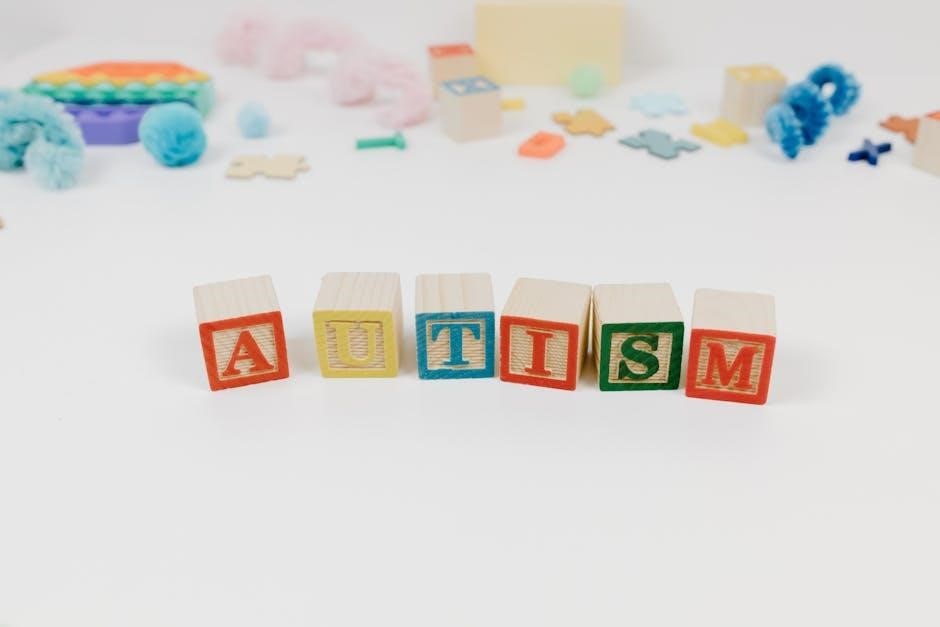Special education acronyms are essential for effective communication and navigation within the special education system, streamlining processes and ensuring consistency in supporting students with diverse needs.
1.1. Importance of Understanding Special Education Acronyms
Understanding special education acronyms is crucial for effective communication among educators, parents, and administrators. These acronyms, such as IEP, 504 Plan, and FAPE, represent key concepts and legal requirements that ensure students receive appropriate support. Misunderstanding them can lead to confusion and potential mismanagement of services. Acronyms like IDEA and LRE highlight the legal framework guiding special education, emphasizing the need for tailored programs in the least restrictive environment. Familiarity with these terms enables stakeholders to navigate the system efficiently, ensuring compliance with federal and state regulations. This knowledge is vital for advocating for students’ rights and delivering high-quality, individualized education programs.
1.2. Common Acronyms in Special Education
In special education, acronyms are frequently used to simplify communication. Common ones include IEP (Individualized Education Program), which outlines a student’s specific needs and goals. The 504 Plan refers to accommodations for students with disabilities under Section 504 of the Rehabilitation Act. IDEA stands for the Individuals with Disabilities Education Act, ensuring FAPE (Free Appropriate Public Education) for all eligible students. LRE (Least Restrictive Environment) emphasizes placing students in the most inclusive setting possible. Other key acronyms include ABA (Applied Behavioral Analysis), AAC (Augmentative and Alternative Communication), and OT (Occupational Therapy). Understanding these acronyms is essential for effective collaboration and ensuring students receive appropriate support.
Key Special Education Acronyms
Key special education acronyms include IEP, 504 Plan, IDEA, FAPE, LRE, ABA, AAC, OT, FERPA, ADA, and DSM. These are essential for understanding special education processes.
2;1. IEP: Individualized Education Program
An IEP, or Individualized Education Program, is a legally binding document tailored for students with disabilities, outlining specific educational goals, accommodations, modifications, and related services. It ensures access to FAPE in the LRE. Developed by a team of educators and parents, the IEP is updated annually to track progress and adjust supports. Key components include present levels of performance, measurable goals, special education services, and participation in assessments. This personalized plan is crucial for addressing unique needs, ensuring students receive targeted interventions and resources to thrive academically and functionally. Regular monitoring and reporting are integral to its effectiveness.
2.2. 504 Plan: Section 504 of the Rehabilitation Act
A 504 Plan is developed under Section 504 of the Rehabilitation Act, ensuring students with disabilities receive accommodations to access education equally. Unlike an IEP, it does not require specialized instruction but focuses on modifications and supports. Eligibility is based on a disability that substantially impacts learning or major life activities. The plan is created by a team, including parents, and outlines accommodations such as extended time, assistive technology, or environmental adjustments. It is reviewed annually and ensures compliance with federal anti-discrimination laws. While similar to an IEP, a 504 Plan has different eligibility criteria and legal standards, focusing on equal access rather than specialized education. It is a vital tool for students who need support but do not qualify for an IEP.
2.3. IDEA: Individuals with Disabilities Education Act
The Individuals with Disabilities Education Act (IDEA) is a federal law ensuring students with disabilities receive free and appropriate public education (FAPE); It mandates personalized education plans, including IEPs, to meet unique needs. IDEA emphasizes least restrictive environment (LRE) placements and requires schools to identify and evaluate eligible students. It provides funding for special education services and safeguards parental rights, such as due process and consent. Regular reauthorizations update the law to improve outcomes for students with disabilities, ensuring access to necessary supports and therapies. IDEA is foundational for special education, promoting equity and inclusion in educational settings nationwide.
2.4. FAPE: Free Appropriate Public Education
Free Appropriate Public Education (FAPE) is a legal right under the Individuals with Disabilities Education Act (IDEA), ensuring students with disabilities receive tailored educational services. FAPE mandates that schools provide instruction and related services to meet individual needs, enabling access to a public education. It requires an IEP or 504 Plan to outline specific goals, accommodations, and supports. FAPE is delivered in the least restrictive environment (LRE), promoting inclusion and maximizing opportunities for learning. This principle ensures equality in education, guaranteeing that every student, regardless of disability, has access to the resources and services necessary for their academic and personal growth. FAPE is a cornerstone of special education law, protecting students’ rights to an appropriate and effective education.
2.5. LRE: Least Restrictive Environment
Least Restrictive Environment (LRE) refers to the educational setting where students with disabilities can learn alongside non-disabled peers as much as possible. LRE is mandated by the Individuals with Disabilities Education Act (IDEA) to ensure that students receive education in the most inclusive environment. Placement options range from general education classrooms with supports to more restrictive settings, depending on individual needs. The goal of LRE is to maximize opportunities for social interaction, academic engagement, and access to the general curriculum. Special education teams collaborate to determine the most appropriate placement, balancing academic benefits with social growth, ensuring students receive a meaningful education in the least restrictive setting possible.

Special Education Disability Categories
Special education disability categories help identify and address diverse student needs, such as emotional or behavioral disorders, learning disabilities, and autism spectrum disorder, guiding tailored support.
3.1. EBD: Emotional or Behavioral Disorders
Emotional or Behavioral Disorders (EBD) refer to chronic, disruptive behaviors that interfere with a student’s learning and social interactions. These disorders are characterized by intense emotions, such as anxiety or aggression, and persistent behavioral challenges, like defiance or impulsivity. EBD differs from occasional behavioral issues, as it is more severe and persistent, requiring specialized interventions. Students with EBD often benefit from tailored support, including behavioral therapy, counseling, and modified learning environments. Under the Individuals with Disabilities Education Act (IDEA), schools must provide individualized plans to address these needs. Positive Behavioral Interventions and Supports (PBIS) and Functional Behavioral Assessments (FBAs) are commonly used to manage and improve outcomes for students with EBD. Early identification and support are critical to helping these students thrive academically and socially.
3.2. LD: Learning Disability
A Learning Disability (LD) refers to a neurological disorder that affects the brain’s ability to process information, impacting skills such as reading, writing, mathematics, and speech. LDs are often identified during childhood and can persist into adulthood. They may manifest as difficulties in understanding spoken or written language, trouble with memory, attention, or coordination, and challenges in completing schoolwork. LDs are not a result of low intelligence or lack of effort but rather stem from differences in brain structure and function. Early identification and intervention are crucial, with strategies like Individualized Education Programs (IEPs), accommodations, and specialized teaching methods helping students overcome these challenges and achieve academic success.
3.3. ASD: Autism Spectrum Disorder
Autism Spectrum Disorder (ASD) is a developmental disability characterized by challenges in social interaction, communication, and restricted or repetitive behaviors. It is termed a “spectrum” because individuals with ASD exhibit varying degrees of severity and impact. Early signs may include delays in speech development, difficulty understanding social cues, and repetitive behaviors. ASD is typically diagnosed in early childhood, though some individuals may not receive a diagnosis until later. Interventions such as Applied Behavioral Analysis (ABA) and Augmentative and Alternative Communication (AAC) are commonly used to support individuals with ASD. Early diagnosis and tailored educational plans, such as Individualized Education Programs (IEPs), are critical for fostering growth and independence in individuals with ASD.

Special Education Programs and Services
Special education programs and services provide tailored support for students with diverse needs, including ABA, AAC, and OT, to promote learning and overall development in inclusive settings.
4.1. ABA: Applied Behavioral Analysis
Applied Behavioral Analysis (ABA) is a scientifically validated approach to understanding and improving behaviors. It is widely used in special education to support individuals with Autism Spectrum Disorder (ASD) and other developmental disabilities. ABA focuses on breaking down skills into smaller, manageable parts and reinforcing positive behaviors while reducing maladaptive ones. Techniques include discrete trial training (DTT), positive reinforcement, and functional behavior assessments. ABA therapy is often delivered in one-on-one settings, such as schools or homes, and is tailored to meet the unique needs of each student. Its goal is to enhance learning, communication, and independence, making it a cornerstone of many special education programs.
4.2. AAC: Augmentative and Alternative Communication
Augmentative and Alternative Communication (AAC) refers to methods or tools used to support individuals who struggle with verbal or written communication. AAC systems can be low-tech, such as picture communication symbols or gesture boards, or high-tech, like speech-generating devices. These tools help individuals express thoughts, needs, and ideas, fostering independence and participation in educational and social settings. AAC is often used with students who have conditions like Autism Spectrum Disorder (ASD), cerebral palsy, or other speech and language impairments. By providing alternative ways to communicate, AAC enables students to engage more effectively in learning and interact with peers and educators, enhancing their overall educational experience and quality of life.
4.3. OT: Occupational Therapy
Occupational Therapy (OT) is a supportive service provided to students with special needs, designed to enhance their ability to perform daily tasks and achieve independence in various environments. OT focuses on improving fine motor skills, hand-eye coordination, sensory processing, and adaptive behaviors. It is often recommended for students with physical, sensory, or cognitive disabilities. Occupational therapists work closely with teachers and families to develop individualized plans tailored to each student’s needs. By addressing these skills, OT helps students participate fully in educational activities, maintaining focus and engagement in the classroom. This support is crucial for fostering academic success and personal growth in special education settings. OT plays a vital role in creating an inclusive and effective learning environment for all students.

Legal and Regulatory Framework
The legal and regulatory framework ensures compliance with laws like IDEA, ADA, and FERPA, protecting the rights of students with disabilities and safeguarding their educational privacy.
5.1. FERPA: Family Educational Rights and Privacy Act
FERPA protects the privacy of students’ education records and gives parents or eligible students the right to inspect, review, and request amendments to these records. Schools must obtain written consent before disclosing personally identifiable information, except in specified circumstances. FERPA applies to all educational institutions receiving federal funds, ensuring confidentiality and safeguarding sensitive student data; It also allows schools to share “directory information” without consent, such as names or grades, unless students opt out. This law is crucial for maintaining trust between families and educational institutions, ensuring transparency and accountability in handling student records.
5.2. ADA: Americans with Disabilities Act
The ADA prohibits discrimination against individuals with disabilities in all areas of public life, including education. It ensures that students with disabilities have equal access to educational programs and activities. Schools must provide reasonable accommodations, such as physical modifications or assistive technologies, to ensure accessibility. The ADA complements other laws like IDEA and Section 504 by broadening protections and promoting inclusion. It requires schools to address barriers in both physical and programmatic access, ensuring students with disabilities can fully participate in educational opportunities. The ADA plays a vital role in fostering an inclusive and equitable learning environment, safeguarding the rights of students with disabilities nationwide.

Additional Resources and References
Key resources include the Diagnostic and Statistical Manual (DSM), IDEA, and state-specific guides. Online glossaries and educational websites provide detailed explanations of special education acronyms and terms.
6.1.Diagnostic and Statistical Manual (DSM)
The Diagnostic and Statistical Manual (DSM) is a critical resource in special education, providing standardized criteria for diagnosing mental and developmental disorders. It is widely used by professionals to identify conditions such as Autism Spectrum Disorder (ASD) and Emotional or Behavioral Disorders (EBD), which are common in special education settings. The DSM helps determine eligibility for services under Individualized Education Programs (IEPs) and 504 Plans. While not exclusively focused on education, its diagnostic framework is essential for understanding student needs. By referencing the DSM, educators and clinicians can align interventions with evidence-based practices, ensuring accurate assessments and appropriate support. This manual is a cornerstone in the special education process, bridging clinical and educational perspectives.